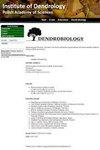欧洲山区铁质杜鹃居群的表型分化
IF 1.8
4区 农林科学
Q2 FORESTRY
引用次数: 1
摘要
铁杜鹃花产于中欧山脉,地理范围在比利牛斯山脉和阿尔卑斯山之间以及阿尔卑斯山和苏台德山脉之间有很大的分离。我们期望这些物种发生的不连续性应该涉及到它们的表型分化,类似于分子标记的研究。本研究的目的是验证来自比利牛斯山脉、阿尔卑斯山和苏台德山脉的物种种群之间的表型差异。采用方差分析、判别分析、主成分分析和欧几里得距离上的聚类分析,对13个种群(每个种群25 ~ 30个个体)的叶片和蒴果性状进行了分析。除蒴果瓣先端角和蒴果形状外,叶片和蒴果性状在不同种群间差异显著(P≤0.001)。尽管如此,即使在最高水平上,性状变异的分化范围在种群之间也存在重叠。判别分析、主成分分析和集聚分析结果相似,表明比利牛斯山脉、阿尔卑斯山脉和苏台德山脉种群之间存在差异。然而,个体之间的差异无法区分地区。叶片和蒴果的形态特征可以区分比利牛斯山脉、阿尔卑斯山脉和苏德斯山脉的铁酸根居群,其表型分化模式与基于遗传标记的描述相似。苏台德地区的遗存种群在表型上与比利牛斯山脉和西阿尔卑斯山的种群更相似,而与空间上最接近的东阿尔卑斯山种群更相似。本文章由计算机程序翻译,如有差异,请以英文原文为准。
Phenotypic differentiation of Rhododendron ferrugineum populations in European mountains
Rhododendron ferrugineum occurs in the mountains of the Central Europe with large disjunction in geographic range between Pyrenees and Alps and between Alps and Sudetes. We expect that these discontinuities in the species occurrence should involved their phenotypic differentiation, similar as described on the studies of molecular markers. The aim of the study was verification of phenotypic differences between the species populations from the Pyrenees, Alps and Sudetes. We examined characters of leaves and capsules from 13 populations, each represented by 25–30 individuals, using ANOVA, discrimination analysis, principal components analysis and agglomeration on the closest Euclidean distances. Every from examined characters of leaves and capsules except of apex angle of a capsule valve and capsule valve shape differentiated between populations at P≤0.001. Despite, range of character variation differentiating even at the highest level overlapped between populations. The analysis of discrimination, principal component analysis and agglomeration gave similar results indicating differences between populations from Pyrenees, Alps and Sudetes. However, the differences between individuals did not allow distinguish regions. The morphological characteristics of the leaves and capsules allowed to distinguish among populations of R. ferrugineum from the Pyrenees, Alps and Sudetes, and the pattern of their phenotypic differentiation was similar to that described based on genetic markers. The relict population from the Sudetes is phenotypically more similar to the populations from the Pyrenees and the Western Alps than to the spatially closest populations from the Eastern Alps.
求助全文
通过发布文献求助,成功后即可免费获取论文全文。
去求助
来源期刊

Dendrobiology
农林科学-林学
CiteScore
2.20
自引率
11.10%
发文量
17
审稿时长
>12 weeks
期刊介绍:
Dendrobiology publishes original research articles and review articles related to the biology of trees and shrubs.
 求助内容:
求助内容: 应助结果提醒方式:
应助结果提醒方式:


